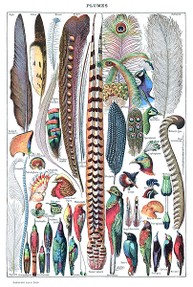
Back in 1918, The Migratory Bird Treaty Act was passed to make it illegal (with a few exceptions) to possess feathers and nests because of the declining population of bird species.
Do you know one of the reasons so many birds were killed for their feathers? ..... to decorate women's hats! Another reason was because collecting eggs and nests was such a popular hobby.
Even though it doesn't seem fair not to be able to pick up a feather or fallen nest, it's too difficult for enforcement officers to prove whether a person had picked it up off the ground, or had killed a bird or pulled a viable nest out of a tree.

Places like nature centers and zoos can have feathers for education, but they must get permits from the U.S. Fish & Wildlife Service, and keep records of what they collect.
So even if you find a pretty cardinal or blue jay feather, don't keep it. You don't want to risk getting in trouble for owning an illegal feather (I put my feather back in the field).
Also, don't pick up and keep a dead bird. You can't even salvage a bird that died from disease, collision with a car, or from electrocution. Salvage permits are required because poaching puts many migratory bird populations at risk. If you find a dead bird or feathers that you think a repository might want, a bird that has been shot or you suspect poisoning, contact the Fish and Wildlife Service or a Game Warden.
The Fish and Wildlife Service has created an online Feather Atlas - a complete list of protected birds.




 ~~ Domestic chicken, goose and duck feathers are OK to keep and they are often shaped and painted to look like feathers of other birds so they be used in craft projects.
~~ Domestic chicken, goose and duck feathers are OK to keep and they are often shaped and painted to look like feathers of other birds so they be used in craft projects.










 I Loved to Read in Grade School (in the 1960s)on 09/29/2018
I Loved to Read in Grade School (in the 1960s)on 09/29/2018
 Halloween Memories from the 1960son 09/17/2018
Halloween Memories from the 1960son 09/17/2018
 What on Earth is Earthing?on 06/03/2015
What on Earth is Earthing?on 06/03/2015
 Worm Manure (Castings) Is The Best Organic Fertilizeron 05/25/2015
Worm Manure (Castings) Is The Best Organic Fertilizeron 05/25/2015



Comments
Here in the UK there is no rule against keeping feathers, but there is a rule against killing birds, with exceptions [vermin and game, on your own land, in season and wildfowl on beaches.] Thus, if you kill an owl, you have committed an offence, and if you pluck a feather from a live owl, it is animal cruelty, but if you find an owl feather and keep it, no offence is committed. Thus, recently a fox had a wood pigeon near my plot, and left the feathers strewn around. I put them in the compost bin. No crime committed. Although the wood pigeon is a vermin species, I have no legal right to shoot them on my plot, as it is rented, but the fox cannot read the rule book. Similarly, I am not allowed to kill any animals on my plot, but I buried a hedgehog that had died naturally. No crime committed.
I was aware it was against the law to shoot owls, hawks, etc, but didn't know that it was illegal to keep their feathers. We live and learn. Interesting!
You probably saw a great horned owl. Large owls have very few predators except for humans and sometimes wildcats. If the owl is no longer there, a wildcat may have gotten it. Owls mostly eat small rodents, but do eat small birds, too. However, most birds don't come out at night. Owls can't chew food, but either eat it whole or tear it apart with their claws. Then they regurgitate bone, fur and feathers.
I see most of the posts on here are pretty old but I am still hoping someone can shed some light on something. I often have owls eat bugs at night under our light pole. Last night I was very entertained by a very large owl. It looked like a line backer as it ran from place to place eating. Big as a raccoon. This morning in the same spot was a large amount of feathers but no dead bird of any kind.Do I assume something happened to it or do they hunt other birds?
FYI - The feather in the photos of this article is a wing feather from a Redtail Hawk. Left wing, first or second primary feather. Owl feathers have different barring pattern, detail spotting and the entire feather will have a 'velvet' appearance on the surface of the feather vane.
Interesting post. :)
Never would have thought of this. But I can see the logic behind it.
I had no idea, I adore owls they are the most beautiful creatures. Thanks for the tips on wildlife does and don'ts. :)K
how interesting
I found this feather on my property and intend to keep it.
I wondered what bird this came from.